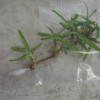 Relying on insecticides for southern chinch bug control raises turfgrass maintenance costs, increases the risk that insects will develop resistance to insecticides, and may damage the environment. Host-plant resistance is a relatively sustainable and environmentally sound option for management of this damaging insect pest.To develop new resistant varieties, plant materials must be screened for new sources of southern chinch bug resistance. Screening methods to measure host plant resistance of St. Augustinegrass to southern chinch bugs have measured nymphal and/or adult survival in so-called no-choice tests in which only the experimental plant materials were provided. There are four types of screening methods described in this 4-page fact sheet was written by Huangjun Lu and Ronald Cherry, and published by the UF Department of Entomology and Nematology, October 2014. (Photo credit: Long Ma, UF/IFAS Extension)
Relying on insecticides for southern chinch bug control raises turfgrass maintenance costs, increases the risk that insects will develop resistance to insecticides, and may damage the environment. Host-plant resistance is a relatively sustainable and environmentally sound option for management of this damaging insect pest.To develop new resistant varieties, plant materials must be screened for new sources of southern chinch bug resistance. Screening methods to measure host plant resistance of St. Augustinegrass to southern chinch bugs have measured nymphal and/or adult survival in so-called no-choice tests in which only the experimental plant materials were provided. There are four types of screening methods described in this 4-page fact sheet was written by Huangjun Lu and Ronald Cherry, and published by the UF Department of Entomology and Nematology, October 2014. (Photo credit: Long Ma, UF/IFAS Extension)
http://edis.ifas.ufl.edu/in1050
Tag: Ronald Cherry
New Sources of Southern Chinch Bug Resistance in St. Augustinegrass
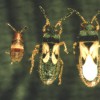 Currently, Captiva is the only chinch bug-resistant variety of St. Augustinegrass grown on sod farms in Florida. But since these pests have previously overcome their resistance to Floratam, it is highly probable that they will do the same with Captiva in the future. It is also desirable to have resistant varieties available with different agronomic qualities such as shade tolerance or drought tolerance. This 4-page fact sheet reports the results of a preliminary screening to detect resistance to chinch bugs, conducted at the UF/IFAS Everglades research station on 36 untested St. Augustinegrass lines. Written by Huangjun Lu and Ronald Cherry, and published by the UF Department of Horticultural Sciences, July 2014.
Currently, Captiva is the only chinch bug-resistant variety of St. Augustinegrass grown on sod farms in Florida. But since these pests have previously overcome their resistance to Floratam, it is highly probable that they will do the same with Captiva in the future. It is also desirable to have resistant varieties available with different agronomic qualities such as shade tolerance or drought tolerance. This 4-page fact sheet reports the results of a preliminary screening to detect resistance to chinch bugs, conducted at the UF/IFAS Everglades research station on 36 untested St. Augustinegrass lines. Written by Huangjun Lu and Ronald Cherry, and published by the UF Department of Horticultural Sciences, July 2014.
http://edis.ifas.ufl.edu/hs1239
Corn wireworm Melanotus communis Gyllenhal (Insecta: Coleoptera: Elateridae)
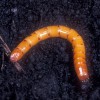 Insects in the family Elateridae are commonly known as click beetles. Their name comes from the clicking sound they make while attempting to right themselves after falling or being placed on their backs. The larvae of click beetles are called wireworms. The corn wireworm is a serious agricultural pest and was added to the EPPO A1 action list of quarantine pests in 2002. This 6-page fact sheet was written by Harsimran K. Gill, Gurminder Chahil, Gaurav Goyal, Jennifer L. Gillett-Kaufman and Ronald Cherry, and published by the UF Department of Entomology and Nematology, January 2014.
Insects in the family Elateridae are commonly known as click beetles. Their name comes from the clicking sound they make while attempting to right themselves after falling or being placed on their backs. The larvae of click beetles are called wireworms. The corn wireworm is a serious agricultural pest and was added to the EPPO A1 action list of quarantine pests in 2002. This 6-page fact sheet was written by Harsimran K. Gill, Gurminder Chahil, Gaurav Goyal, Jennifer L. Gillett-Kaufman and Ronald Cherry, and published by the UF Department of Entomology and Nematology, January 2014.
http://edis.ifas.ufl.edu/in1025
Stink Bugs in Florida Rice
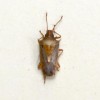 Although many different insects can be found in rice fields in Florida, stink bugs are currently considered the most important pest. Jones and Cherry reported that the rice stink bug was the dominant species, comprising more than 95% of the total stink bug population. Cherry et al. (1998) reported that the stink bug Oebalus ypsilongriseus was widespread in Florida rice fields. This was the first report of this species being found in commercial rice fields in the United States. Cherry and Nuessly (2010) reported that the stink bug Oebalus insularis is now widespread in Florida rice fields. This was the first report of this species being found in commercial rice fields in the United States. The stink bug complex attacking Florida rice is the most diversified and unique stink bug complex in US rice production. This 4-page fact sheet was written by Ron Cherry, and published by the UF Department of Entomology and Nematology, October 2013.
Although many different insects can be found in rice fields in Florida, stink bugs are currently considered the most important pest. Jones and Cherry reported that the rice stink bug was the dominant species, comprising more than 95% of the total stink bug population. Cherry et al. (1998) reported that the stink bug Oebalus ypsilongriseus was widespread in Florida rice fields. This was the first report of this species being found in commercial rice fields in the United States. Cherry and Nuessly (2010) reported that the stink bug Oebalus insularis is now widespread in Florida rice fields. This was the first report of this species being found in commercial rice fields in the United States. The stink bug complex attacking Florida rice is the most diversified and unique stink bug complex in US rice production. This 4-page fact sheet was written by Ron Cherry, and published by the UF Department of Entomology and Nematology, October 2013.
http://edis.ifas.ufl.edu/in1009
Silicon Effects on Resistance of St. Augustinegrass to Southern Chinch Bugs and Plant Disease
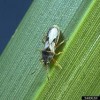 Silicon (Si) is the second most common element on earth, but it is not considered an essential element for plant growth. However, a growing body of evidence has shown that Si can enhance plant resistance to insect pests. This 5-page fact sheet reports the results of a study to determine if silicon applications to St. Augustinegrass varieties increase the silicon in the plants and how this increased silicon affects development and survival of southern chinch bugs as well as development of plant diseases. Written by Alan L. Wright, Ron Cherry, Huangjun Lu, and Pamela Roberts, and published by the UF Department of Soil and Water Science, September 2013.
Silicon (Si) is the second most common element on earth, but it is not considered an essential element for plant growth. However, a growing body of evidence has shown that Si can enhance plant resistance to insect pests. This 5-page fact sheet reports the results of a study to determine if silicon applications to St. Augustinegrass varieties increase the silicon in the plants and how this increased silicon affects development and survival of southern chinch bugs as well as development of plant diseases. Written by Alan L. Wright, Ron Cherry, Huangjun Lu, and Pamela Roberts, and published by the UF Department of Soil and Water Science, September 2013.
http://edis.ifas.ufl.edu/ss589
Tropical sod webworm Herpetogramma phaeopteralis Guenee (Insecta: Lepidoptera: Crambidae) (EENY541/IN968)
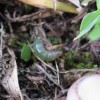 Tropical sod webworm larvae are destructive pests of warm season turfgrasses in the southeastern U.S., especially on newly established sod, lawns, athletic fields, and golf courses. Larval feeding damage reduces turfgrass aesthetics, vigor, photosynthesis and density. The first sign of damage is often caused by differences in grass height in areas where larvae are feeding. This 5-page fact sheet was written by Nastaran Tofangsazie, Steven P. Arthurs, and Ronald Cherry, and published by the UF Department of Entomology and Nematology, November 2012.
Tropical sod webworm larvae are destructive pests of warm season turfgrasses in the southeastern U.S., especially on newly established sod, lawns, athletic fields, and golf courses. Larval feeding damage reduces turfgrass aesthetics, vigor, photosynthesis and density. The first sign of damage is often caused by differences in grass height in areas where larvae are feeding. This 5-page fact sheet was written by Nastaran Tofangsazie, Steven P. Arthurs, and Ronald Cherry, and published by the UF Department of Entomology and Nematology, November 2012.
http://edis.ifas.ufl.edu/in968